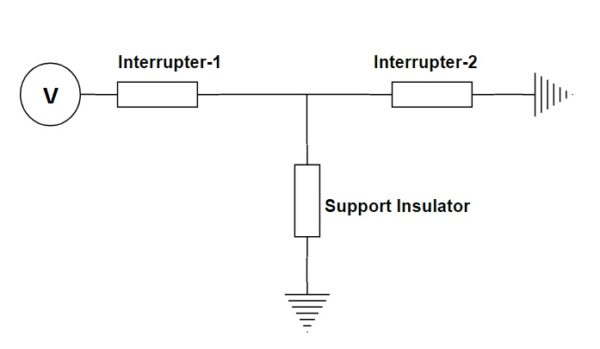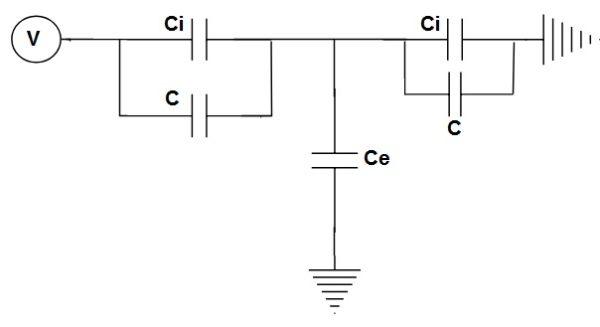Grading capacitor is used in EHV circuit breakers for achieving uniform voltage distribution across the contacts of multi-break circuit breaker. Multi-break circuit breaker here means that a single breaker having more than once interrupter unit. These capacitors are connected in parallel with each of the interrupter unit. In this post, we will discuss the effect of Grading capacitor in voltage distribution across the contacts of breaker. For this we will go through the calculation of voltage distribution with Grading Capacitor across the breaker contacts.
Let us consider a double break circuit breaker for the sake of our analysis. A double break circuit breaker has two interrupter units connected in series. Across each of the interrupter unit, Grading capacitor having typical value of 500 pF is connected. Figure below shows the simplified diagram of a double break circuit breaker mounted over the support insulator.

The two interrupter units are shown by Interruptter-1 and Interrupter-2. In the above figure, grading capacitor is not shown. This breaker will have three types of capacitance:
- Capacitance of the interrupter unit with contacts in open condition in SF6 dielectric medium (Ci)
- Capacitance of live part to earth of support insulator column (Ce)
- Grading capacitor connected across each interrupter unit (C)
Considering the above three types of associated capacitance, the electrical equivalent circuit of the above breaker will be as shown below.

Let us assume that,
Voltage across the interrupter-1 = V1
Voltage across the interrupter-2 = V2
Since Ci and C are parallel connected & Ci, C and Ce are also connected in parallel, therefore, above equivalent circuit can be represented as

Now, as per the voltage division rule
V2 = (Ci+C) / [(Ci+C)+(Ci+C+Ce)]
= (Ci+C) / (2Ci+2C+Ce)
Since the clearance at the support insulator column is almost double to that of clearance in interrupter unit, therefore it is justified to assume Ce = 0.5Ci
V2 = (Ci+C) / (2Ci+2C+0.5Ci)
= (Ci+C) / (2.5Ci+2C)
Since the value of capacitance of the interrupter unit with contacts in open (Ci) is normally very very less than to that of value of grading capacitor, therefore Ci may be ignored w.r.t C.
V2 = C / 2C
= 1/2
Thus from the above expression we can conclude that, voltage across each interrupter unit is distributed to approximately 50% of the applied voltage. This means, if a double break circuit breaker with grading capacitor is used in 400 kV system, then voltage across each of the breaker contact will be equally distributed. This means, the voltage across each interrupter unit will be approximately 200 kV.
Voltage equalization by using grading capacitor has great advantage. Due to this, breaker design for high voltage i.e. 765 kV is possible. Normally in 765 kV system, a circuit break have four interrupter units. So voltage across each interrupter will be approx 192 kV. Therefore breaker contacts, insulation, SF6 gas pressure etc are chosen for this voltage level.
Nice explanation. I would like to know the voltage distribution when other end of CB is open or floating.
Why capacitors are used.. If we use only double break than also be the voltage across them is almost half.. we can check this through above equation with C=0. Then what is need of capacitors in such places.
Hello Vishal Nadiad